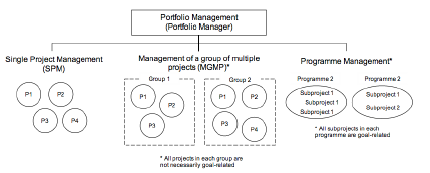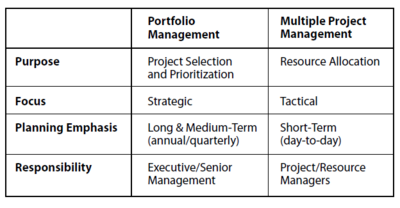Effective Tools for Multiple Project Management
Manas Dalvi (Talk | contribs) |
Manas Dalvi (Talk | contribs) |
||
| Line 136: | Line 136: | ||
==References== | ==References== | ||
| − | <references | + | <references/> |
<ref name="MPM1">Dooley, L., Lupton, G., O’Sullivan, D. (2004), Multiple project management: A modern competitive necessity.</ref> | <ref name="MPM1">Dooley, L., Lupton, G., O’Sullivan, D. (2004), Multiple project management: A modern competitive necessity.</ref> | ||
<ref name="MPM2">Payne, JH. (1995), Management of multiple simultaneous projects: a state-of-the art review.</ref> | <ref name="MPM2">Payne, JH. (1995), Management of multiple simultaneous projects: a state-of-the art review.</ref> | ||
Revision as of 21:57, 19 February 2021
Contents |
Abstract
Due to exponential advancements across various sectors, project management professionals are expected to manage a portfolio of projects in their respective organizations due to limitation for resources. These portfolios can be interdisciplinary at times and their individual status in the cycle would differ. During such times it becomes difficult for these professionals to run parallel with these updates. Losing focus may lead to build an ineffective strategy, non-optimized resource management, lack in control and communication, etc. which would further affect the performance of the individual and also of the organization as a whole.
This article gives an insight of Multiple Project Management (MPM), its necessity, classifications and causes for ineffective MPM. Moreover, it further explains the methodologies that one must consider while resolving these causes. In the view of limited empirical research on MPM, this article puts in a comprehensive overview of tools and its application in effective management of multi-projects.
Multiple Project Management (MPM)
Multiple Project Management as the name suggests is the management of multiple projects operated simultaneously. These projects can be sub-projects of a big project, various projects in a program or similar projects across different portfolios. Projects are managed parallelly irrespective of their current stats in their project life cycle. It has become more common in organizations and for project managers to handle several projects running simultaneously, known as multi-project management.[5] Organizations exercise simultaneous management of projects on a daily basis to meet markets demands. It has also been suggested that up to 90%, by value, of all projects occur in the multi-project context.[2]
With the lack of experienced professionals in every sector, project managers are now made to handle multiple projects in order to meet the accelerating demands of industry. Project Managers are tasked to lead more than one project because of resource limitation, these managers are referred to as multiple project management and such condition can also be referred to as management of a group of multiple projects.[4]
A Project Manager has to devout his majority of time for switching things between various projects that are undertaken, this may include planning, administrative and execution related input with different stakeholders at the same time. There can be a major time investment in menial jobs such a tracing project schedule, managing and communicating teams, setup and follow-up for reaching deadlines and many more.
These things are difficult even while handling a single project, whereas in MPM the degree of complexity rises exponentially with the increasing number of projects that are handled. In the view of MPM’s requirement, the potential for improvement is significant in management of simultaneous process. [2] However, there is no universal tool that addresses every concern in MPM. So far, the MPM settings has limited empirical foundation, most contributions are either based on practical experiences or a research finding from one particular industry. There is little knowledge concerning which factors are context specific or universal. [6] Even though take into all these considerations in account, there are some generalized issues that have been encountered in a multi project managing environment. This article highlights the tools effective for tackling these issues, with their limitation as a generalized tool.
Project vs Program vs Portfolio vs Multiple Projects in Project Management
- Project: It is a task that has a certain delivery time, cost and quality. A project should ideally have a start date and an end date, generally goal oriented projects. These are short terms tasks undertaken as per business requirements. For eg: manufacturing of screens for cell phone.
- Program: A program is an array of multiple projects. It may consist of similar projects that contribute to a common goal. All the projects consisting in a program are usually interdependent and should be executed considering its effects in mind. For eg: Manufacturing cell phone.
- Portfolio: Portfolio is a generalized profile of consisting of various programs or projects. For example, Manufacturing of mobile, earphones, camera, etc.
- Multiple Project Management: A group of projects assigned to a particular manager with similar, dependent or unique characteristics. These projects can be from various programs or portfolios.
These differentiations can be better understood when referred to Fig 1. as it gives an overview of how each of these are unique.
Generally, MPM is compared to Portfolio Management since both of the cases requires interdisciplinary management to achieve diverse goals. However, Fig 2 gives an overview on how MPM differs from Portfolio Management.
Challenges with MPM
Considering the diversity of the projects handled in MPM, managers tackle challenges on a frequent basis. Looking at the prior art it is very difficult to tabulate these standards into a standard list as projects are unique and challenges associated with the can be uncertain at times. These challenges can vary as the nature of project varies from time to time and these natures of project can affect the efficiency of MPM. For instance, explained by J. Payne in his work of reviewing MPM, he gives three key differences a project because of which managing them would get complicated. The key differences between projects in a portfolio are in terms of size, required skills and urgency.
There are also some challenges that are specifically highlighted related to managing multiple projects Cite error: Closing </ref> missing for <ref> tag [1] [2] [3] [4] [5] [6] [7] [8] [9]
Cite error:
<ref> tags exist, but no <references/> tag was found

